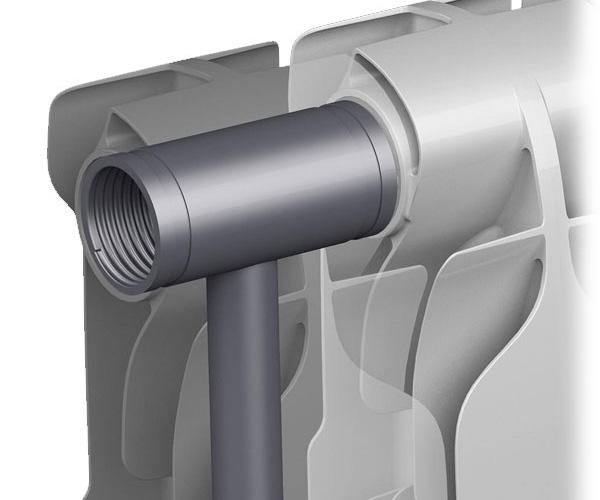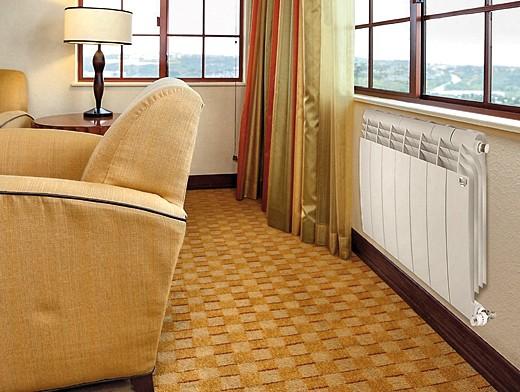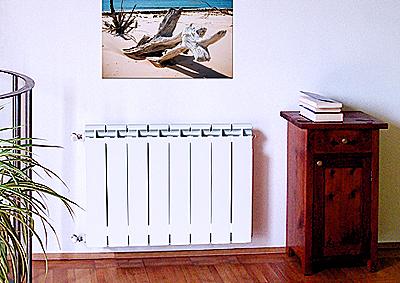Bimetal radiators have their advantages
Batteries are an integral part of any heating system, and the efficiency of its operation largely depends on their correct choice. Therefore, it is important to study in detail the existing assortment, delve into its features, analyze the advantages and disadvantages of each type of product. Let's talk about the technical characteristics of bimetallic radiators, outline their advantages and disadvantages, and touch on the nuances of choice.
What is a bimetal radiator?
Modern manufacturers are constantly experimenting and releasing new generation products, devoid of the shortcomings of previous models. Not so long ago, the choice of the domestic buyer was small. For more than 50 years, only cast iron batteries have been used, ideally suited to the central heating system.
Cast iron is the least susceptible to corrosion, it is not afraid of hydraulic shocks and withstands high pressure inside the system. This metal, although it heats up slowly, retains heat well and cools slowly. High and operational terms of cast-iron radiators. But they have a couple of significant drawbacks - an unsightly appearance and too much weight. When new decor requirements arose, it became clear that these products did not fit into the concept of new styles at all.
Then aluminum analogues appeared - compact, efficient and very attractive in appearance. Many liked the original design, but it turned out that aluminum batteries can not be used everywhere. Aluminum is a soft metal that is very afraid of an alkaline environment. Alkali, reacting with it, destroys and thins it, making it look like a sponge. Over time, there is a great risk of rupture of the heater, and everyone knows how such accidents end.
Note! It is because of the low-quality coolant that it is impossible to use aluminum radiators in the central heating system. Steel batteries are not suitable for it either, because steel is afraid of oxygen. It oxidizes, and corrosive processes begin to develop rapidly in the devices, leading to a rapid breakdown of the battery.
In addition, steel proved to be less effective than aluminum. Therefore, manufacturers have long dreamed of developing a product that can overcome the described difficulties. So radiators were born, made of an alloy of two metals - aluminum and steel, as well as aluminum and copper.
History of appearance
It is difficult today to say exactly who owned the idea of creating such an interesting product. There is a legend about this.
At one of the productions, the usual technical surveys were carried out. The technologists were given the task of casting an aluminum section with perfectly even channels. These sections were cast entirely under high pressure. To form a cavity inside, a strong rod was inserted into the workpiece. Then it was taken out with great difficulty, and this laborious work took a lot of time.
One of the engineers suggested that the molding rod be replaced with a steel tube, which then would not need to be removed. We tried it - it worked, but the cost of the product increased significantly. However, at the same time, the cost of manufacturing aluminum sections has decreased. And when the difference was calculated, it turned out that all expenses were mutually compensated.
The new technology was successfully tested, and a heating device was born, marking the beginning of a new generation of radiators.

With this design, many problems can be avoided.
The described type of devices has a peculiar structure. The coolant is transported through a steel or copper pipe, which is enclosed in a high-quality aluminum casing. It has no contact with water. Hot water heats the steel casing, which, in turn, heats the aluminum casing, which gives off heat to the room. What does it give? Tons of benefits.
In the production of bimetallic products, the inner core is first welded from steel, and then it is poured with an aluminum-silicon alloy. The quality of steel and welding affects the reliability of the product. The inner tubes are manufactured using seamless drawing technology, and the individual parts are connected using short circuit technology. Hidden defects can form inside, the most common of which is surface porosity. But this does not affect the operation of the device in any way, since aluminum does not come into contact with hot water.
The ribs are made with a certain step, and each has a characteristic bend. Therefore, the design is able to reproduce the maximum thrust that creates turbulent eddies. The principle of action is as follows. Cold air is taken in from below, and aluminum, which has a high heat dissipation, heats it up as quickly as possible. Hot air rises, cools down, and sinks down.
Convection is considered more efficient, and the appearance of bimetallic devices is no different from aluminum. There is only one characteristic that will help "by eye" to distinguish the described varieties from each other - this is weight. Bimetallic batteries weigh more than aluminum ones.
Tangible benefits
- Firstly, the new generation product has increased resistance to corrosion phenomena. The fact is that all steel parts are coated from the inside with special polymers that prevent oxidative processes.
- Secondly, a vertical collector is made of steel, capable of withstanding a pressure of 20-40 atmospheres. And this despite the fact that the domestic central system has a working pressure of 15 atmospheres. Therefore, even in the event of a water hammer, the radiator will withstand it completely.
- Thirdly, bimetallic batteries have a small diameter of internal channels. This means that a small amount of coolant is required to fill them. The volume of water is 3 times less than that of cast iron counterparts, so bimetallic products weigh much less.
- Fourthly, many models are equipped with a thermostat that independently controls the heating mode. It is not possible to install it in cast iron products.

Such a radiator fits well into any interior.
Thus, the technical characteristics of bimetallic radiators can be identified very clearly:
- High level of heat transfer - 170-190 W.
- Average working pressure - 20 atmospheres.
- Small amount of coolant.
- High resistance to the chemical composition of the coolant.
- Large model range.
The described devices have one significant drawback. To date, these are the most expensive batteries. It will be extremely expensive to change the entire system and install bimetallic radiators in all areas of the apartment, so for now they are not so popular.
Selection Options

Bimetal radiator pipes are made of steel
Anyone who decides to give preference to such batteries must take into account certain criteria when choosing models. First of all, you need to take into account the functional purpose of the room. For non-standard rooms, overall dimensions are suitable.
It is useful to contact the utility service organizations in advance and ask them what operating pressure the heating system has. And then study the technical data sheet of the product in detail. It should pay attention to the thermal power of the device, the volume of each section, the total weight of the product, the permissible temperature level of the coolant, as well as the guarantees given by the manufacturer.
Note! Bimetallic radiators "do not like" draining water in the system, since steel parts quickly oxidize. For this reason, experts do not recommend choosing these devices for installation in apartment buildings. As a rule, all the water from the batteries is drained there for the summer.
As you can see, it is bimetallic radiators that have the greatest number of advantages - their characteristics indicate that these are the most durable and reliable heating devices.
Generalization on the topic
Bimetallic radiators have become known all over the world in just a few years. Today the product market is constantly growing. Devices are produced in the form of separate sections, which are then assembled into a structure of the required power. The sections are interconnected by a nipple system.
